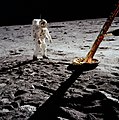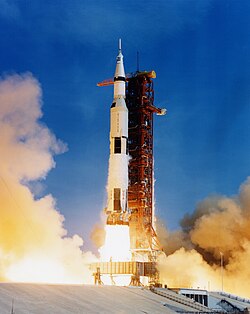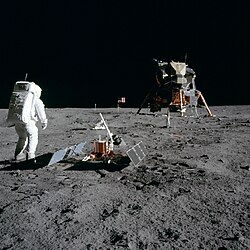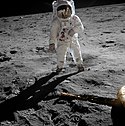Apollo 11
| Missionsemblem | |||||
|---|---|---|---|---|---|
 | |||||
| Missionsstatistik[1] | |||||
| Missionsnavn: | Apollo 11 | ||||
| Kommandomodul: | CM-107 Columbia | ||||
| Servicemodul: | SM-107 | ||||
| Månemodul: | LM-5 Eagle | ||||
| Løfteraket: | Saturn V SA-506 | ||||
| Antal besætningsmedlemmer: | 3 | ||||
| Affyringsrampe: | Kennedy Space Center, Florida LC 39A | ||||
| Opsendelse: | 16. juli 1969 13:32:00 UTC | ||||
| Månelanding: | 20. juli 1969 20:17:40 UTC Stilhedens hav 0° 40' 26.69" N, 23° 28' 22.69" E (baseret på IAU Mean Earth Polar Axis koordinatsystem) | ||||
| Månevandringslængde: | 2 t 31 min 40 s | ||||
| Tid på månens overflade: | 21 t 36 min 20 s | ||||
| Indsamlede månesten: | 21,55 kg | ||||
| Landing: | 24. juli 1969 16:50:35 UTC 13°19′N 169°9′V / 13.317°N 169.150°V | ||||
| Varighed: | 195 t 18 min 35 s | ||||
| Masse: | CSM: 30,320 kg LM: 16,448 kg | ||||
| Foto af besætningen | |||||
Fra venstre: Armstrong, Collins og Aldrin | |||||
| Navigation | |||||
| |||||
 | Neil Armstrong "That's one small step for [a] man, one giant leap for mankind" Er der problemer med lyden? Se da eventuelt Hjælp:Ogg Vorbis eller "Media help" (engelsk) |
Apollo 11-missionen var den første bemandede månelanding. Det var den femte bemandede mission i Apollo-programmet. Neil Armstrong blev det første menneske, der betrådte Månen, fulgt af Buzz Aldrin. Michael Collins forblev i kredsløb om Månen. Da Armstrong trådte ned på måneoverfladen, udtalte han de kendte ord.
| Det er kun et lille skridt for mennesket, men et kæmpespring for menneskeheden. | ||
| Neil Armstrong | ||
Oprindeligt:
| That's one small step for [a] man, one giant leap for mankind. | ||
| Neil Armstrong | ||
Højdepunkter
- Den 16. juli 1969 kl. 13:32 letter Apollo 11-raketten fra Jorden, og det bliver set af millioner Verden over.
- Den 20. juli - om søndagen - blev månelandingsfartøjet, kaldet Ørnen, skilt fra kommandosektionen Columbia i kredsløb om Månen. Collins forblev i Columbia mens Ørnen med Armstrong og Aldrin om bord påbegyndte månelandingen.
- Efter en omhyggelig kontrol blev landingsmotoren på Ørnen tændt og nedstigningen begyndte. Under landingen bemærkede astronauterne at det planlagte landingssted var mere klippefyldt end forventet. Armstrong overtog derfor kontrollen og styrede månelandingsfartøjet ned på et mere jævnt terræn, senere kendt som Stilhedens base, beliggende i Stilhedens Hav.
- Den 21. juli kl. 03:56:20 dansk tid, seks en halv time efter landingen, steg Armstrong ned på Månens overflade og udtalte de berømte ord: "Det er kun et lille skridt for et menneske, men et kæmpespring for menneskeheden."
- Efter 21 timer og 36 minutter på Månens overflade, blev startraketten på Ørnen tændt og de to astronauter vendte tilbage til Columbia medbringende 22 kg månesten. Astronauterne vendte tilbage til Jorden den 24. juli og blev modtaget som helte efter 21 dages karantæne. Karantænen skyldtes faren for eventuelle månebakterier.
Missionen i tal
- Masse:
- Affyring: 2.923.387 kg
- Rumfartøj: 46.678 kg
- CSM-masse: 30.320 kg, heraf CM 5.960 kg og SM 24.360 kg
- LM-masse: 16.448 kg , heraf landingsdel 11.463 kg og returdelen 4.985 kg
- Jordkredsløb: halvandet kredsløb før turen mod Månen, knap ét på tilbagetur
- Månekredsløb: 31
Besætning
- Neil Alden Armstrong, kaptajn
- Michael Collins, kommandomodulpilot
- Edwin "Buzz" Aldrin, pilot på månelandingsfartøj
Efterskrift
Kommandomodulet Columbia er udstillet på National Air and Space Museum (en), Washington D.C. Overdelen af månelandingsmodulet Eagle blev forladt den 21. juli 1969 i månekredsløb. Nedstyrtningsstedet på Månen er ukendt.
Den 21. marts 2013 fandt et bjærgningshold, betalt af IT-milliardæren Jeff Bezos (Amazon-stifter og inkarneret rumfartsentusiast), to Rocketdyne F-1 (en) raketmotorer, der for mere end 40 år siden sendte Apollomissioner ud i rummet. Saturn V-rakettens førstetrin havde fem F-1-motorer, og faldt i Atlanterhavet når det havde brugt sit brændstof. Det vides ikke med sikkerhed om de fundne raketmotorer er fra Apollo 11-missionen[2].
Billeder
- Jorden set fra Månen
- Aldrins støvleaftryk
- Astronaut "Buzz" Aldrin på månevandring nær ved et af Eagles ben
- Edwin E. Aldrin med Armstrong vist som en refleks i visiret
- Aldrin fjerner seismometre fra månelandingsfartøjet
- Aldrin står ved målestationen PSEP, med månelandingsfartøjet i baggrunden
Se også
Noter og referencer
- ^ Richard W. Orloff. "Apollo by the Numbers: A Statistical Reference (SP-4029)". NASA. Arkiveret fra originalen 16. marts 2011. Hentet 30. juni 2007.
- ^ Mr. Amazon, Jeff Bezos, recovers Apollo 11 engines from Atlantic seabed Arkiveret 23. marts 2013 hos Wayback Machine euronews.com 21/03/2013
Eksterne henvisninger
 | Wikimedia Commons har medier relateret til: |
- NASA: Apollo 11 Lunar Surface Journal Arkiveret 16. januar 2012 hos Wayback Machine (engelsk)
- Apollo 11 entry in Encyclopedia Astronautica (engelsk)
- Map of activities on Lunar surface for Apollo 11 (engelsk)
- Description of The Lunar Module Computer (engelsk)
Medier brugt på denne side
Apollo 11 crew portrait
Forfatter/Opretter: Gnome?, Licens: GPL
SVG recreation of Gnome speakernotes.
The Apollo 11 Saturn V space vehicle lifted off with Astronauts Neil A. Armstrong, Michael Collins and Edwin E. Aldrin Jr. at 9:32 a.m. EDT July 16, 1969, from Kennedy Space Center's Launch Complex 39A.
View of the Earth from the Command Module Columbia, soon after AOS on Rev 6. As seen from the Moon, the angular diameter of Earth is about 1.9 degrees. Between the times that 6547 and 6549 are taken, the Earth rises about 0.37 diameters or about 0.7 degrees and, with an orbital period of two hours, the interval between 6547 and 6549 can be estimated as 14 seconds.
Famous speech from Neil Armstrong: At 2:56 UTC on July 21, 1969, Armstrong made his descent to the Moon's surface and spoke his famous line "That's one small step for [a] man, one giant leap for mankind" exactly six and a half hours after landing.
Astronaut Edwin E."Buzz" Aldrin Jr., Lunar Module pilot, is photographed during the Apollo 11 extravehicular activity on the Moon. He has just deployed the Early Apollo Scientific Experiments Package (EASEP). In the foreground is the Passive Seismic Experiment Package (PSEP); beyond it is the Laser Ranging Retro-Reflector (LR-3); in the center background is the United States flag; in the left background is the black and white lunar surface television camera; in the far right background is the Lunar Module "Eagle". Astronaut Neil A. Armstrong, commander, took this photograph with a 70mm lunar surface camera.
- Short description: Astronaut Buzz Aldrin on the moon
- Full description: Astronaut Buzz Aldrin, lunar module pilot, stands on the surface of the moon near the leg of the lunar module, Eagle, during the Apollo 11 moonwalk. Astronaut Neil Armstrong, mission commander, took this photograph with a 70mm lunar surface camera. While Armstrong and Aldrin descended in the lunar module to explore the Sea of Tranquility, astronaut Michael Collins, command module pilot, remained in lunar orbit with the Command and Service Module, Columbia. The picture features additionally to Aldrin, in his visor as reflections, Armstrong, Earth,[1] the lander, as well as the placed flag and instruments.
- This is the actual photograph as exposed on the moon by Armstrong. He held the camera slightly rotated so that the camera frame did not include the top of Aldrin's portable life support system ("backpack"). A communications antenna mounted on top of the backpack is also cut off in this picture. When the image was released to the public, it was rotated clockwise to restore the astronaut to vertical for a more harmonious composition, and a black area was added above his head to recreate the missing black lunar "sky". The edited version is the one most commonly reproduced and known to the public, but the original version, above, is the authentic exposure. A full explanation with illustrations can be seen at the Apollo Lunar Surface Journal.
Buzz is standing just beyond the north strut. Note the distinctive dust smudges on Buzz's legs. The photo also shows the furrows in the bulk sample area and the area to the left of the footpad that shows unmistakable signs of sweeping by the descent engine exhaust. In a detail Ulli Lotzmann notes a reflected image of the rendezvous radar.
Buzz Aldrin removing the passive seismometer from a compartment in the SEQ bay of the Lunar Lander.
Apollo 11 Hasselblad image from film magazine 40/S - EVA
The NASA Special Publication 246, Lunar Photographs from Apollos 8, 10, and 11 (1971) has the following caption for this photo:
- This overhead view shows a detailed section of the lunar surface and the amount of compaction caused by the weight of a man.
This photo was used in Figure 1-27 in the Apollo 11 Preliminary Science Report (NASA SP-214), 1969, which has the following caption:
- The astronaut photographed his own footprint to permit later study of the lunar surface bearing strength. The thin, crusty appearance of the surface was similar to that discovered during the Surveyor soil mechanics experiments. (NASA AS11-40-5877)
This photo was used again in Figure 3-12 in the Apollo 11 Preliminary Science Report, which has the following caption:
- Hasselblad photograph AS11-40-5877 showing an astronaut's bootprint in the lunar surface.
This photo was used again in Figure 4-24 in the Apollo 11 Preliminary Science Report, which has the following caption:
- Same surface as shown in figure 4-23 after having been stepped on by an astronaut. Note the bulged and cracked region in front and to the sides of the footprint. (NASA AS11-40-5877)
















